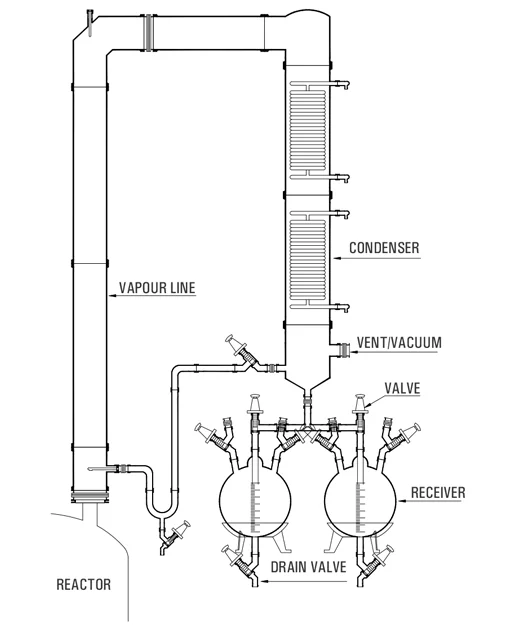Assemblies Over Glass Lined Reactor
Glass Lined Reactors are used instead of glass reactors specially when scale of operation is large and relatively high pressure steam is to be used as heating media. Quite often assemblies like Simple Distillation Unit, Reaction Distillation Unit, Fractional Distillation Unit etc. are installed above glass lined reactors.
The basic features of these assemblies remain the same but glass shell and tube heat exchanger is preferred due to large scale of operation. A typical fractional distillation unit type assembly over GLR is shown in adjacent figure.
| Cat.Ref. | Reactor Cap. | Vapour column | Condenser HTA M2 |
|---|---|---|---|
| GRU 250 | 250 L | 80mmX1.5m | 1.5X2 |
| GRU 500 | 500 L | 100mmX2m | 1.5X2 |
| GRU 1000 | 1000 L | 100mmX2m | 2.5X2 |
| GRU 2000 | 2000 L | 150mmX3m | 2.5X3 |
| GRU 3000 | 3000 L | 150mmX2m | 4.0X2 |
FAQs
1. What factors should be considered when choosing an assembly for a glass-lined reactor?
Here are some key factors to consider:
Desired Separation Process: The type of distillation or other separation process you need to perform will determine the most suitable assembly configuration (simple distillation, fractional distillation, etc.).
Operating Conditions: Pressure, temperature, and the type of chemicals involved will influence the selection of materials for the assembly components (e.g., gasket material compatibility).
Capacity Requirements: The size of the assembly needs to match the processing volume you require.
Here are some resources that can help you calculate the amount of rings needed:
Packing calculators offered by Raschig ring manufacturers
Engineering reference books on distillation and absorption columns
2. What are some common assemblies installed above glass-lined reactors?
YCommon assemblies installed above glass-lined reactors include Simple Distillation Units, Reaction Distillation Units, and Fractional Distillation Units. These assemblies are designed to take advantage of the strengths of glass-lined reactors, including their ability to handle corrosive materials and high temperatures
3. What are the advantages of Glass lined reactors?
Clean Operation: The non-stick nature of glass prevents materials from adhering to the reactor walls. This ensures purity in products & simplifies cleaning
Thermal Shock Resistance : Glass- lined reactors can withstand sudden temperature chances, which is vital in processes that involve heating & cooling cycle .
4. What are disadvantages of glass-lined reactors?
Some disadvantages of glass reactors are : They have limited pressure & temperature ranges . They are relatively prone to mechanical damage or cracking.

